brake JEEP WRANGLER 2012 JK / 3.G Owner's Manual
[x] Cancel search | Manufacturer: JEEP, Model Year: 2012, Model line: WRANGLER, Model: JEEP WRANGLER 2012 JK / 3.GPages: 124, PDF Size: 5.48 MB
Page 94 of 124
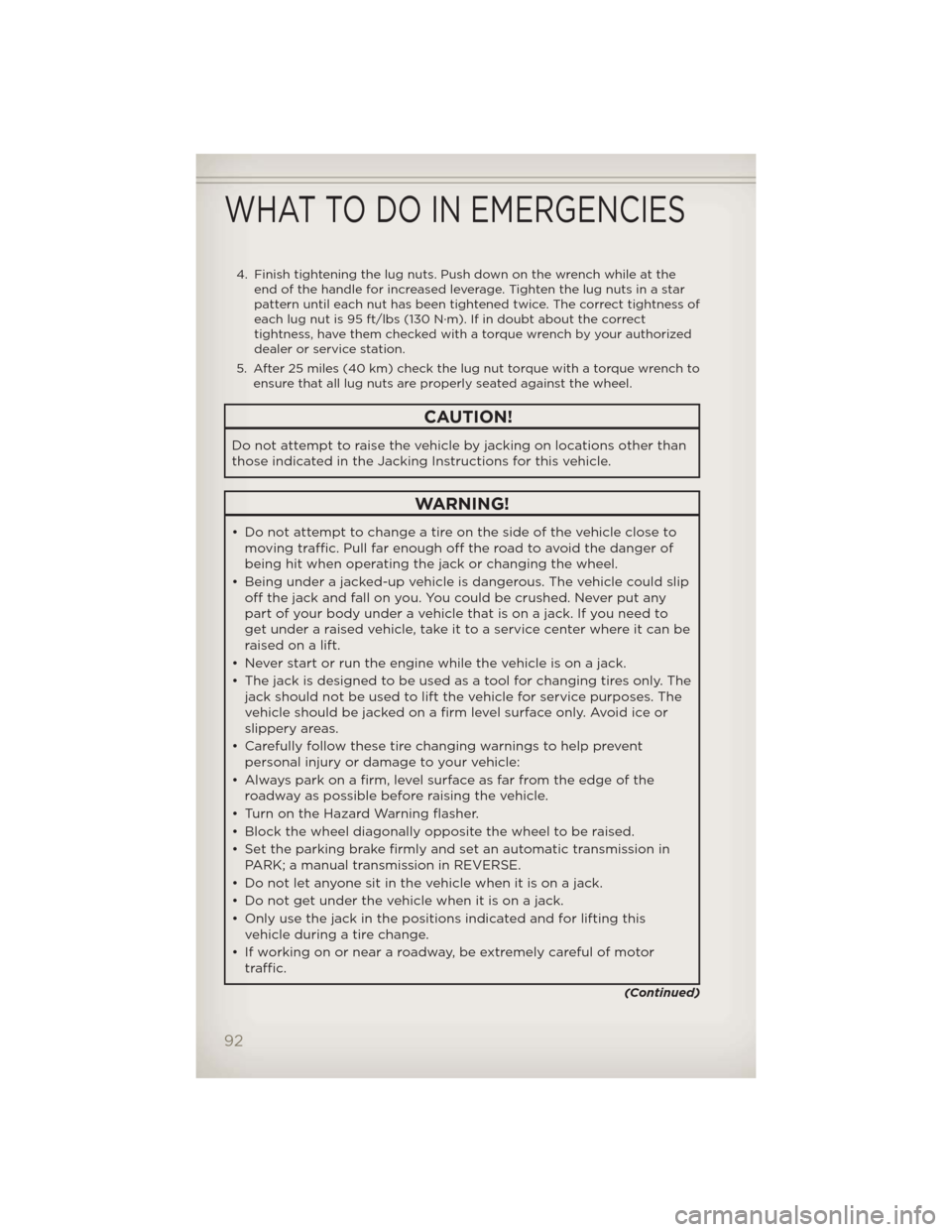
4. Finish tightening the lug nuts. Push down on the wrench while at the
end of the handle for increased leverage. Tighten the lug nuts in a star
pattern until each nut has been tightened twice. The correct tightness of
each lug nut is 95 ft/lbs (130 N·m). If in doubt about the correct
tightness, have them checked with a torque wrench by your authorized
dealer or service station.
5. After 25 miles (40 km) check the lug nut torque with a torque wrench to
ensure that all lug nuts are properly seated against the wheel.
CAUTION!
Do not attempt to raise the vehicle by jacking on locations other than
those indicated in the Jacking Instructions for this vehicle.
WARNING!
• Do not attempt to change a tire on the side of the vehicle close to
moving traffic. Pull far enough off the road to avoid the danger of
being hit when operating the jack or changing the wheel.
• Being under a jacked-up vehicle is dangerous. The vehicle could slip
off the jack and fall on you. You could be crushed. Never put any
part of your body under a vehicle that is on a jack. If you need to
get under a raised vehicle, take it to a service center where it can be
raised on a lift.
• Never start or run the engine while the vehicle is on a jack.
• The jack is designed to be used as a tool for changing tires only. The
jack should not be used to lift the vehicle for service purposes. The
vehicle should be jacked on a firm level surface only. Avoid ice or
slippery areas.
• Carefully follow these tire changing warnings to help prevent
personal injury or damage to your vehicle:
• Alwayspark on a firm, level surface as far from the edge of the
roadway as possible before raising the vehicle.
• Turn on the Hazard Warning flasher.
• Block the wheel diagonally opposite the wheel to be raised.
• Set the parking brake firmly and set an automatic transmission in
PARK; a manual transmission in REVERSE.
• Do not let anyone sit in the vehicle when it is on a jack.
• Do not get under the vehicle when it is on a jack.
• Only use the jack in the positions indicated and for lifting this
vehicle during a tire change.
• If working on or near a roadway, be extremely careful of motor
traffic.
(Continued)
WHAT TO DO IN EMERGENCIES
92
Page 95 of 124
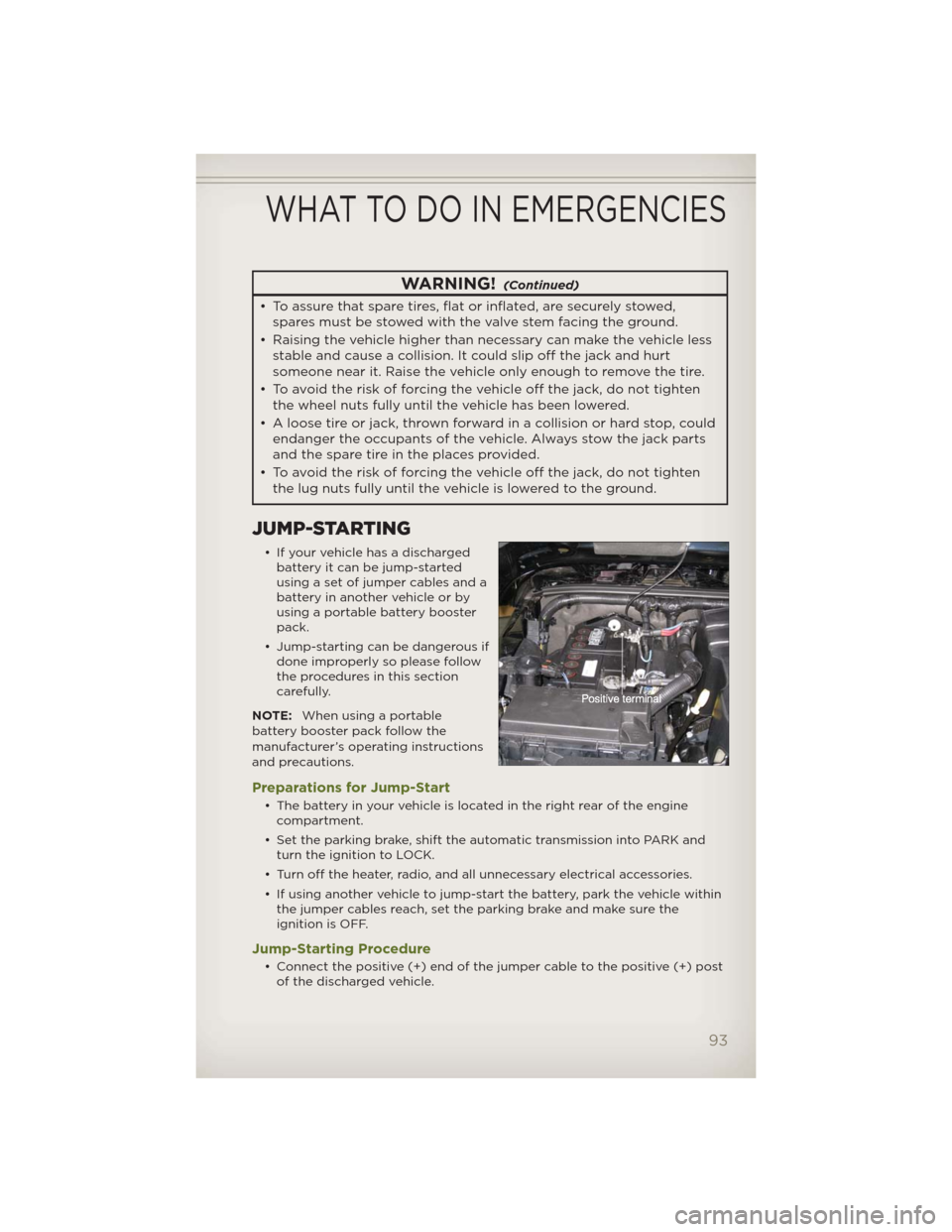
WARNING!(Continued)
• To assure that spare tires, flat or inflated, are securely stowed,
spares must be stowed with the valve stem facing the ground.
• Raising the vehicle higher than necessary can make the vehicle less
stable and cause a collision. It could slip off the jack and hurt
someone near it. Raise the vehicle only enough to remove the tire.
• To avoid the risk of forcing the vehicle off the jack, do not tighten
the wheel nuts fully until the vehicle has been lowered.
• A loose tire or jack, thrown forward in a collision or hard stop, could
endanger the occupants of the vehicle. Always stow thejack parts
and the spare tire in the places provided.
• To avoid the risk of forcing the vehicle off the jack, do not tighten
the lug nuts fully until the vehicle is lowered to the ground.
JUMP-STARTING
• If your vehicle has a discharged
battery it can be jump-started
using a set of jumper cables and a
battery in another vehicle or by
using a portable battery booster
pack.
• Jump-starting can be dangerous if
done improperly so please follow
the procedures in this section
carefully.
NOTE:When using a portable
battery booster pack follow the
manufacturer’s operating instructions
and precautions.
Preparations for Jump-Start
• The battery in your vehicle is located in the right rear of the engine
compartment.
• Set the parking brake, shift the automatic transmission into PARK and
turn the ignition to LOCK.
• Turn off the heater, radio, and all unnecessary electrical accessories.
• If using another vehicle to jump-start the battery, park the vehicle within
the jumper cables reach, set the parking brake and make sure the
ignition is OFF.
Jump-Starting Procedure
• Connect the positive (+) end of the jumper cable to the positive (+) post
of the discharged vehicle.
WHAT TO DO IN EMERGENCIES
93
Page 98 of 124
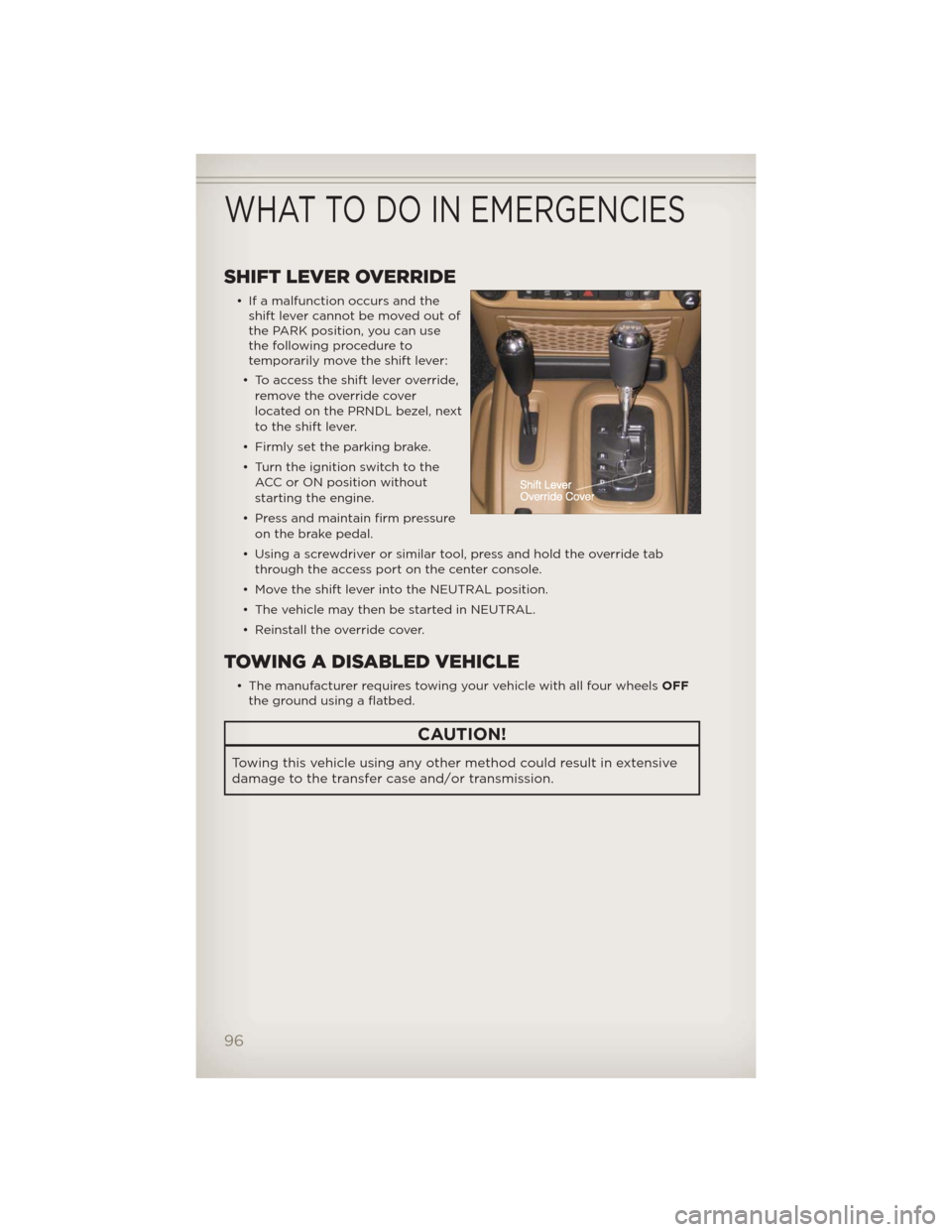
SHIFT LEVER OVERRIDE
• If a malfunction occurs and the
shift lever cannot be moved out of
the PARK position, you can use
the following procedure to
temporarily move the shift lever:
• To access the shift lever override,
remove the override cover
located on the PRNDL bezel, next
to the shift lever.
• Firmly set the parking brake.
• Turn the ignition switch to the
ACC or ON position without
starting the engine.
• Press and maintain firm pressure
on the brake pedal.
• Using a screwdriver or similar tool, press and hold the override tab
through the access port on the center console.
• Move the shift lever into the NEUTRAL position.
• The vehicle may then be started in NEUTRAL.
• Reinstall the override cover.
TOWING A DISABLED VEHICLE
• The manufacturer requires towing your vehicle with all four wheelsOFF
the ground using a flatbed.
CAUTION!
Towing this vehicle using any other method could result in extensive
damage to the transfer case and/or transmission.
WHAT TO DO IN EMERGENCIES
96
Page 100 of 124
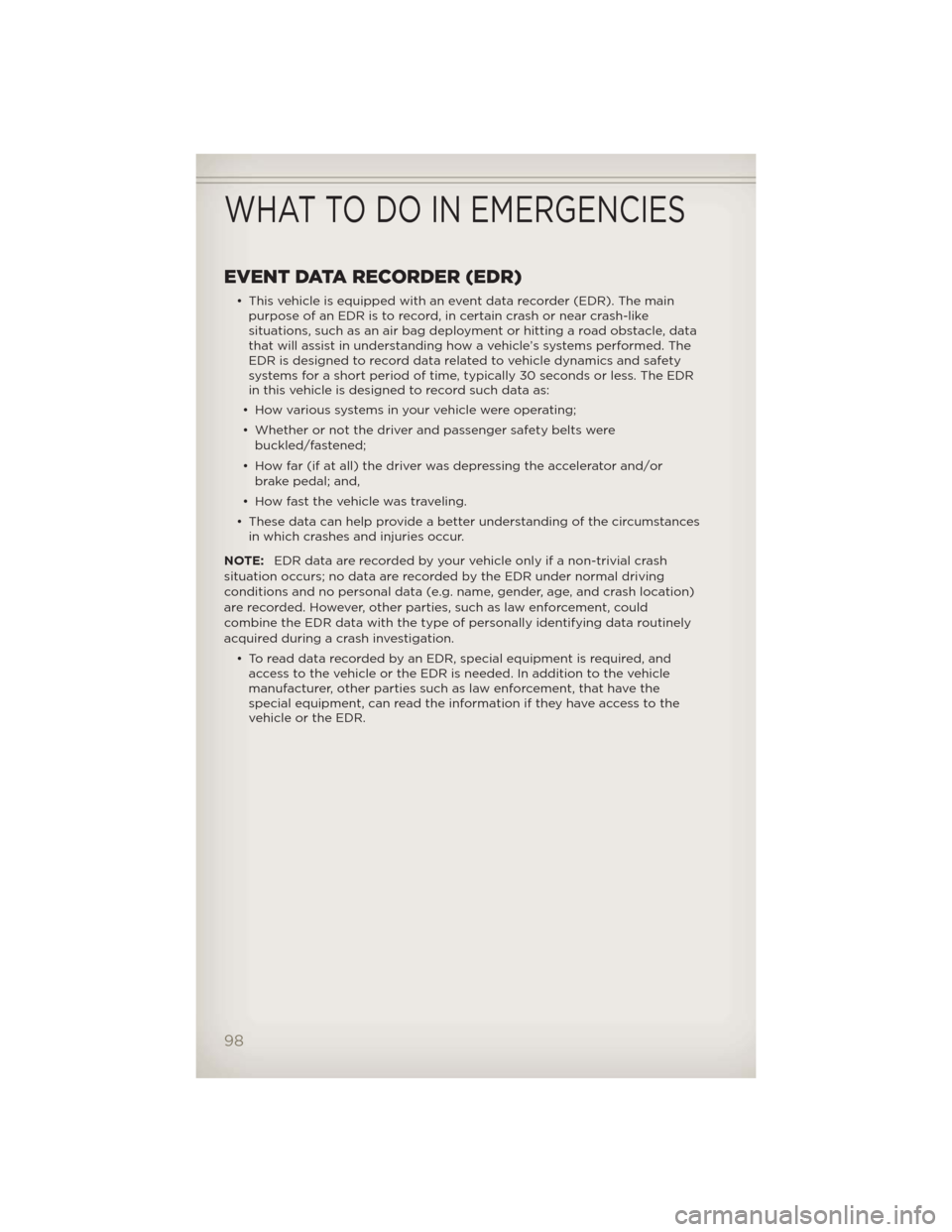
EVENT DATA RECORDER (EDR)
• This vehicle is equipped with an event data recorder (EDR). The main
purpose of an EDR is to record, in certain crash or near crash-like
situations, such as an air bag deployment or hitting a road obstacle, data
that will assist in understanding how a vehicle’s systems performed. The
EDR is designed to record data related to vehicle dynamics and safety
systems for a short period of time, typically 30 seconds or less. The EDR
in this vehicle is designed to record such data as:
• How various systems in your vehicle were operating;
• Whether or not the driver and passenger safety belts were
buckled/fastened;
• How far (if at all) the driver was depressing the accelerator and/or
brake pedal; and,
• How fast the vehicle was traveling.
• These data can help provide a better understanding of the circumstances
in which crashes and injuries occur.
NOTE:EDR data are recorded by your vehicle only if a non-trivial crash
situation occurs; no data are recorded by the EDR under normal driving
conditions and no personal data (e.g. name, gender, age, and crash location)
are recorded. However, other parties, such as law enforcement, could
combine the EDR data with the type of personally identifying data routinely
acquired during a crash investigation.
• To read data recorded by an EDR, special equipment is required, and
access to the vehicle or the EDR is needed. In addition to the vehicle
manufacturer, other parties such as law enforcement, that have the
special equipment, can read the information if they have access to the
vehicle or the EDR.
WHAT TO DO IN EMERGENCIES
98
Page 104 of 124
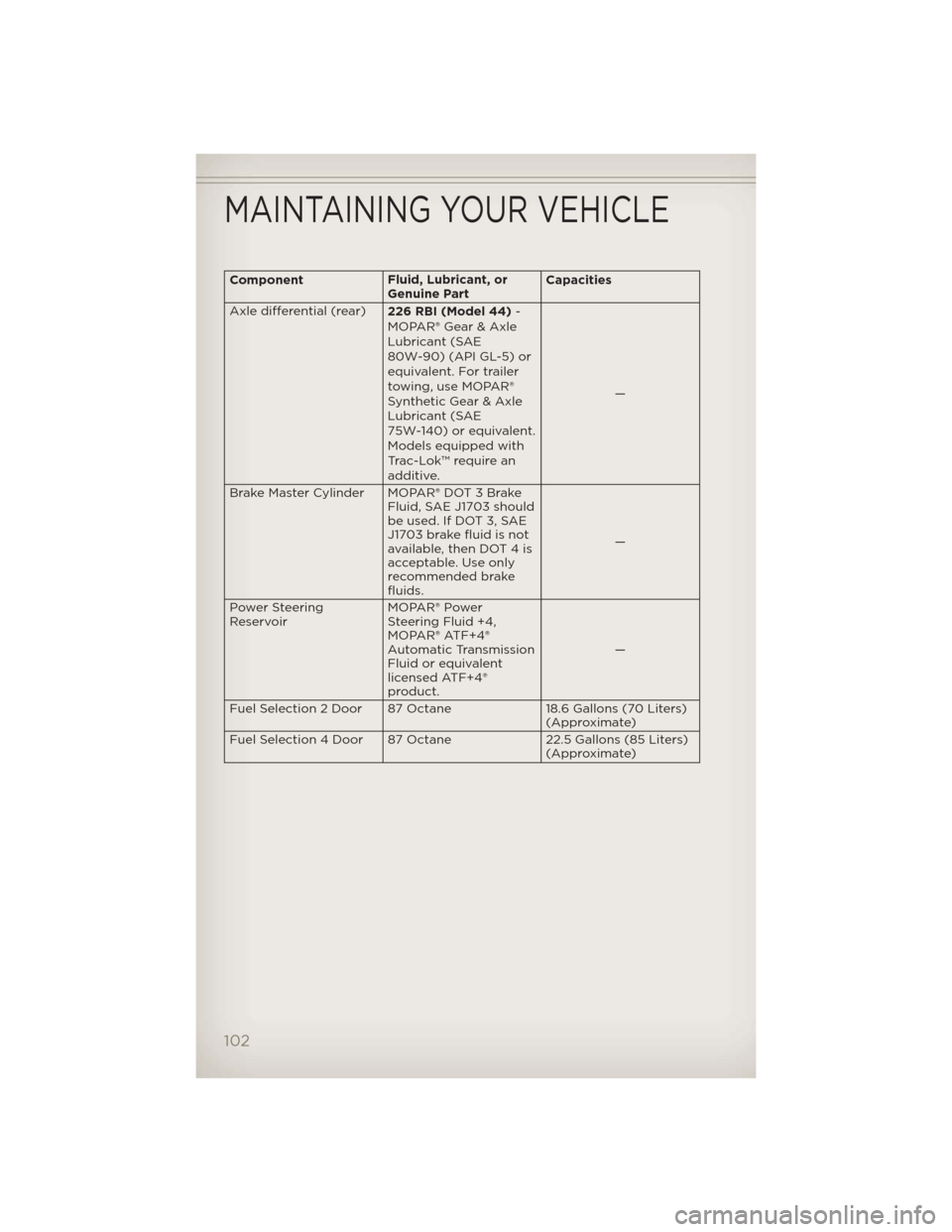
ComponentFluid, Lubricant, or
Genuine PartCapacities
Axle differential (rear)
226 RBI (Model 44)-
MOPAR® Gear & Axle
Lubricant (SAE
80W-90) (API GL-5) or
equivalent. For trailer
towing, use MOPAR®
Synthetic Gear & Axle
Lubricant (SAE
75W-140) or equivalent.
Models equipped with
Trac-Lok™ require an
additive.—
Brake Master Cylinder MOPAR® DOT 3 Brake
Fluid, SAE J1703 should
be used. If DOT 3, SAE
J1703 brake fluid is not
available, then DOT 4 is
acceptable. Use only
recommended brake
fluids.—
Power Steering
ReservoirMOPAR® Power
Steering Fluid +4,
MOPAR® ATF+4®
Automatic Transmission
Fluid or equivalent
licensed ATF+4®
product.—
Fuel Selection 2 Door 87 Octane 18.6 Gallons (70 Liters)
(Approximate)
Fuel Selection 4 Door 87 Octane 22.5 Gallons (85 Liters)
(Approximate)
MAINTAINING YOUR VEHICLE
102
Page 105 of 124
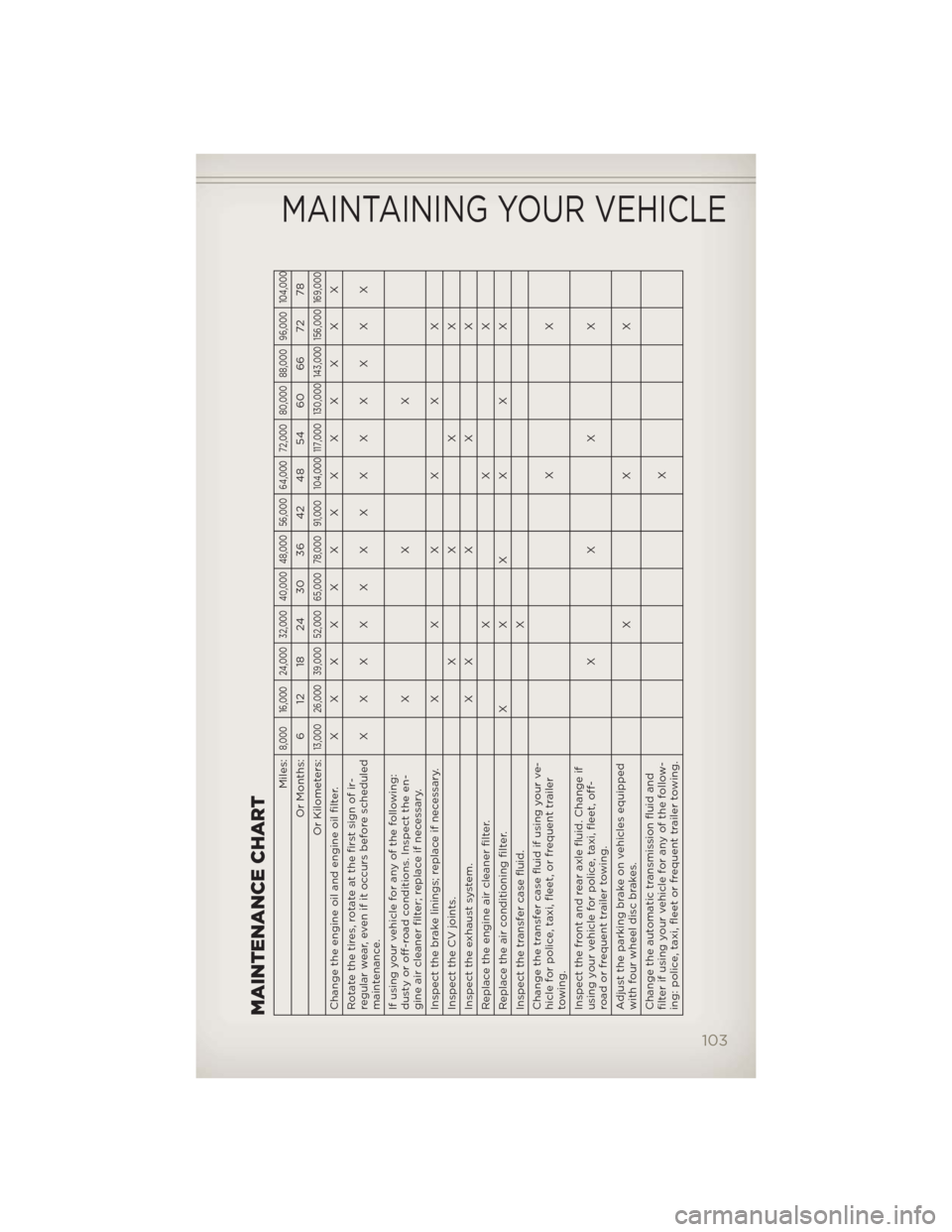
MAINTENANCE CHART
Miles:
8,000 16,000 24,000 32,000 40,000 48,000 56,000 64,000 72,000 80,000 88,000 96,000 104,000
Or Months: 6 12 18 24 30 36 42 48 54 60 66 72 78
Or Kilometers:
13,000 26,000 39,000 52,000 65,000 78,000 91,000 104,000 117,000 130,000 143,000 156,000 169,000
Change the engine oil and engine oil filter.XXXXXXXXXXXXX
Rotate the tires, rotate at the first sign of ir-
regular wear, even if it occurs before scheduled
maintenance.XXXXXXXXXXXXX
If using your vehicle for any of the following:
dusty or off-road conditions. Inspect the en-
gine air cleaner filter; replace if necessary.XXX
Inspect the brake linings; replace if necessary.XXXXXX
InspecttheCVjoints. XXXX
Inspecttheexhaustsystem. XXXXX
Replace the engine air cleaner filter. X X X
Replace the air conditioning filter. X X X X X X
Inspect the transfer case fluid. X
Change the transfer case fluid if using your ve-
hicle for police, taxi, fleet, or frequent trailer
towing.XX
Inspect the front and rear axle fluid. Change if
using your vehicle for police, taxi, fleet, off-
road or frequent trailer towing.XXXX
Adjust the parking brake on vehicles equipped
with four wheel disc brakes.XXX
Change the automatic transmission fluid and
filter if using your vehicle for any of the follow-
ing: police, taxi, fleet or frequent trailer towing.X
MAINTAINING YOUR VEHICLE
103
Page 109 of 124
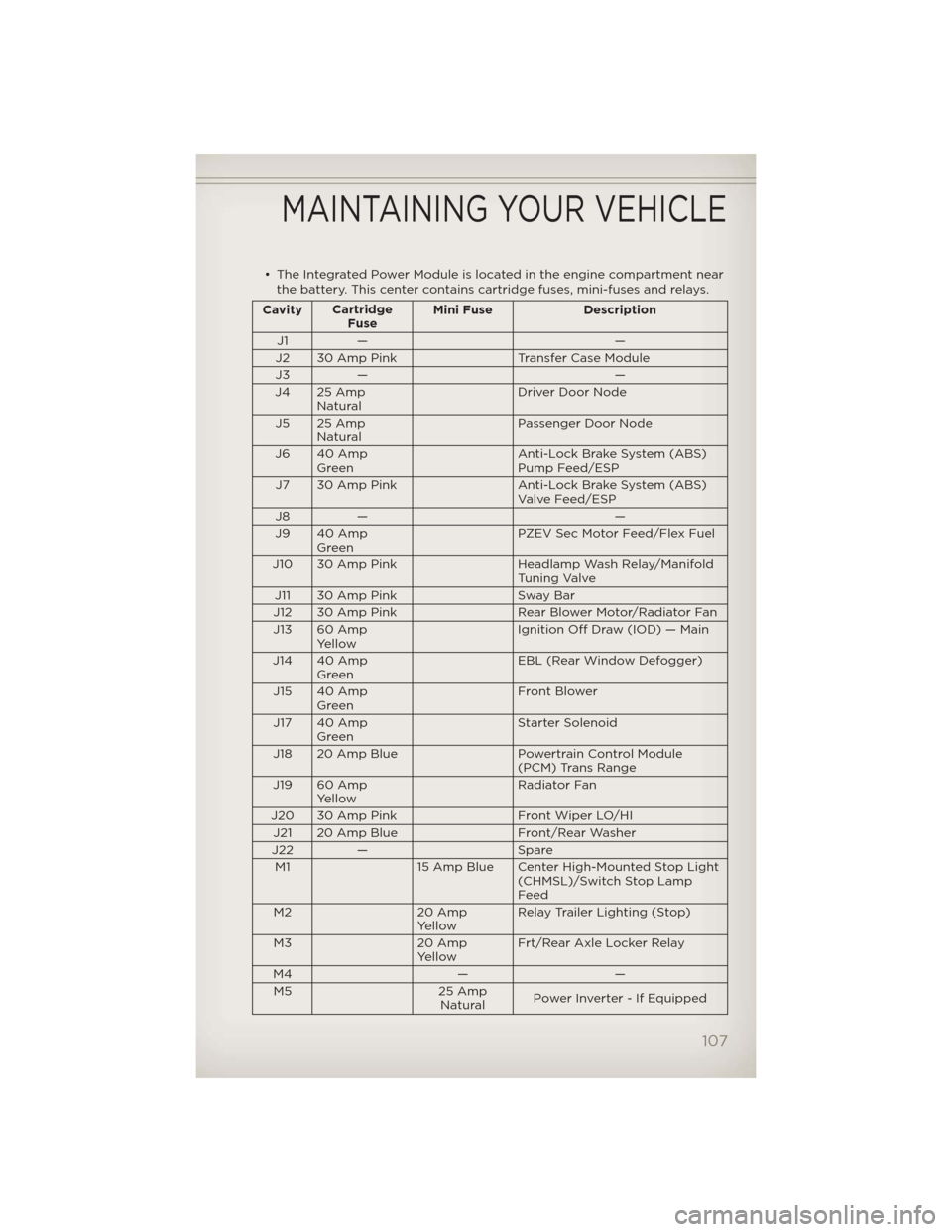
• The Integrated Power Module is located in the engine compartment near
the battery. This center contains cartridge fuses, mini-fuses and relays.
CavityCartridge
FuseMini Fuse Description
J1 — —
J2 30 Amp Pink Transfer Case Module
J3 — —
J4 25 Amp
NaturalDriver Door Node
J5 25 Amp
NaturalPassenger Door Node
J6 40 Amp
GreenAnti-Lock Brake System (ABS)
Pump Feed/ESP
J7 30 Amp Pink Anti-Lock Brake System (ABS)
Valve Feed/ESP
J8 — —
J9 40 Amp
GreenPZEV Sec Motor Feed/Flex Fuel
J10 30 Amp Pink Headlamp Wash Relay/Manifold
Tuning Valve
J11 30 Amp Pink Sway Bar
J12 30 Amp Pink Rear Blower Motor/Radiator Fan
J13 60 Amp
YellowIgnition Off Draw (IOD) — Main
J14 40 Amp
GreenEBL (Rear Window Defogger)
J15 40 Amp
GreenFront Blower
J17 40 Amp
GreenStarter Solenoid
J18 20 Amp Blue Powertrain Control Module
(PCM) Trans Range
J19 60 Amp
YellowRadiator Fan
J20 30 Amp Pink Front Wiper LO/HI
J21 20 Amp Blue Front/Rear Washer
J22 — Spare
M1 15 Amp Blue Center High-Mounted Stop Light
(CHMSL)/Switch Stop Lamp
Feed
M2 20 Amp
YellowRelay Trailer Lighting (Stop)
M3 20 Amp
YellowFrt/Rear Axle Locker Relay
M4 — —
M5 25 Amp
NaturalPower Inverter - If Equipped
MAINTAINING YOUR VEHICLE
107
Page 111 of 124
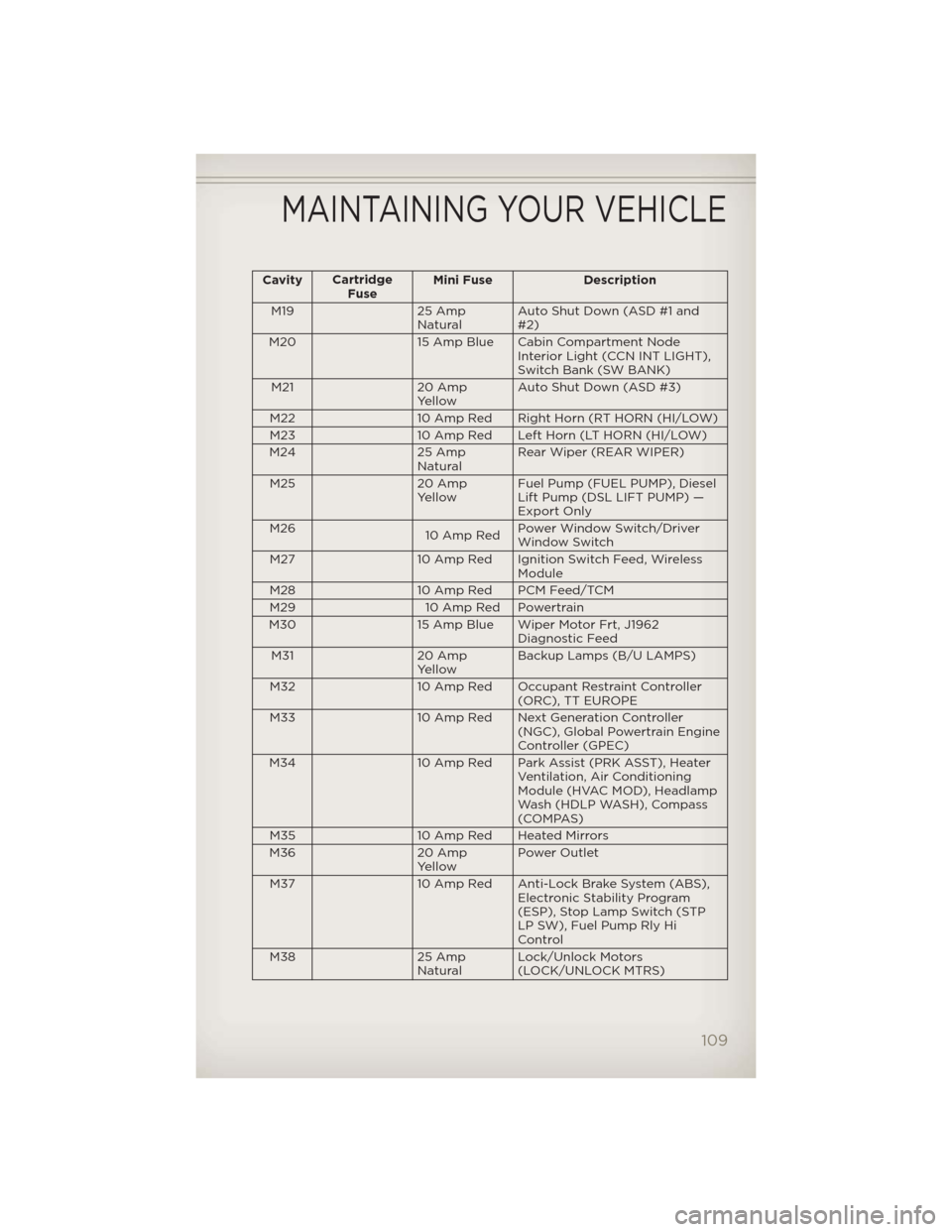
CavityCartridge
FuseMini Fuse Description
M19 25 Amp
NaturalAuto Shut Down (ASD #1 and
#2)
M20 15 Amp Blue Cabin Compartment Node
Interior Light (CCN INT LIGHT),
Switch Bank (SW BANK)
M21 20 Amp
YellowAuto Shut Down (ASD #3)
M22 10 Amp Red Right Horn (RT HORN (HI/LOW)
M23 10 Amp Red Left Horn (LT HORN (HI/LOW)
M24 25 Amp
NaturalRear Wiper (REAR WIPER)
M25 20 Amp
YellowFuel Pump (FUEL PUMP), Diesel
Lift Pump (DSL LIFT PUMP) —
Export Only
M26
10 Amp RedPower Window Switch/Driver
Window Switch
M27 10 Amp Red Ignition Switch Feed, Wireless
Module
M28 10 Amp Red PCM Feed/TCM
M29 10 Amp Red Powertrain
M30 15 Amp Blue Wiper Motor Frt, J1962
Diagnostic Feed
M31 20 Amp
YellowBackup Lamps (B/U LAMPS)
M32 10 Amp Red Occupant Restraint Controller
(ORC), TT EUROPE
M33 10 Amp Red Next Generation Controller
(NGC), Global Powertrain Engine
Controller (GPEC)
M34 10 Amp Red Park Assist (PRK ASST), Heater
Ventilation, Air Conditioning
Module (HVAC MOD), Headlamp
Wash (HDLP WASH), Compass
(COMPAS)
M35 10 Amp Red Heated Mirrors
M36 20 Amp
YellowPower Outlet
M37 10 Amp Red Anti-Lock Brake System (ABS),
Electronic Stability Program
(ESP), Stop Lamp Switch (STP
LP SW), Fuel Pump Rly Hi
Control
M38 25 Amp
NaturalLock/Unlock Motors
(LOCK/UNLOCK MTRS)
MAINTAINING YOUR VEHICLE
109
Page 113 of 124
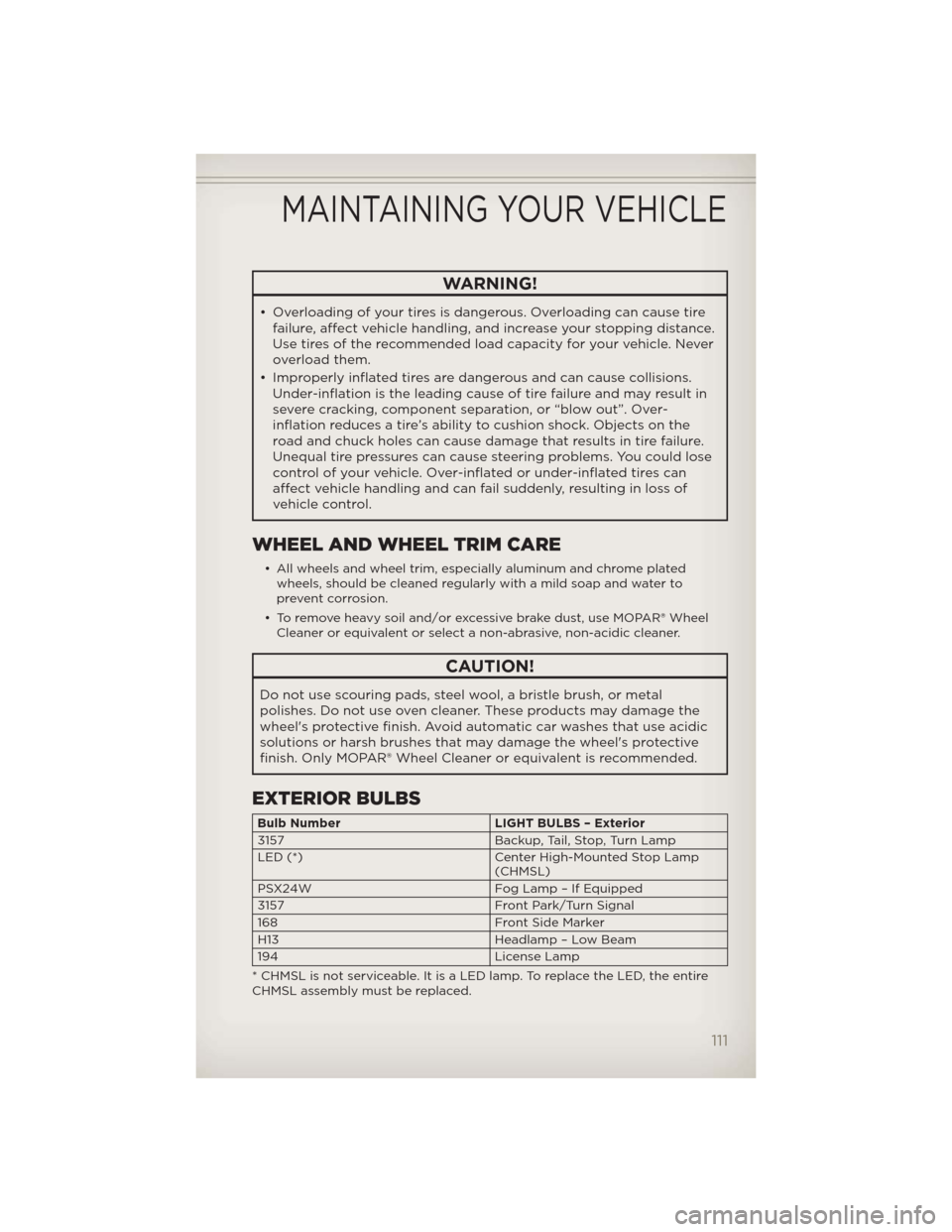
WARNING!
• Overloading of your tires is dangerous. Overloading can cause tire
failure, affect vehicle handling, and increase your stopping distance.
Use tires of the recommended load capacity for your vehicle. Never
overload them.
• Improperly inflated tires are dangerous and can cause collisions.
Under-inflation is the leading cause of tire failure and may result in
severe cracking, component separation, or “blow out”. Over-
inflation reduces a tire’s ability to cushion shock. Objects on the
road and chuck holes can cause damage that results in tire failure.
Unequal tire pressures can cause steering problems. You could lose
control of your vehicle. Over-inflated or under-inflated tires can
affect vehicle handling and can fail suddenly, resulting in loss of
vehicle control.
WHEEL AND WHEEL TRIM CARE
• All wheels and wheel trim, especially aluminum and chrome plated
wheels, should be cleaned regularly with a mild soap and water to
prevent corrosion.
• To remove heavy soil and/or excessive brake dust, use MOPAR® Wheel
Cleaner or equivalent or select a non-abrasive, non-acidic cleaner.
CAUTION!
Do not use scouring pads, steel wool, a bristle brush, or metal
polishes. Do not use oven cleaner. These products may damage the
wheel's protective finish. Avoid automatic car washes that use acidic
solutions or harsh brushes that may damage the wheel's protective
finish. Only MOPAR® Wheel Cleaner or equivalent is recommended.
EXTERIOR BULBS
Bulb Number LIGHT BULBS – Exterior
3157 Backup, Tail, Stop, Turn Lamp
LED (*) Center High-Mounted Stop Lamp
(CHMSL)
PSX24W Fog Lamp – If Equipped
3157 Front Park/Turn Signal
168 Front Side Marker
H13 Headlamp – Low Beam
194 License Lamp
* CHMSL is not serviceable. It is a LED lamp. To replace the LED, the entire
CHMSL assembly must be replaced.
MAINTAINING YOUR VEHICLE
111